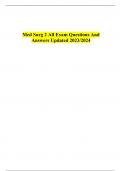Exam (elaborations)
Med Surg 2 All Exam Questions And Answers Updated 2023/2024
- Course
- Institution
Med Surg 2 All Exam Questions And Answers Updated 2023/2024 Med Surg 2 All Exam Questions And Answers Updated 2023/2024 Exam 1, 2 & 3 1. A client is sent home with a Holter monitor. The most import...
[Show more]



